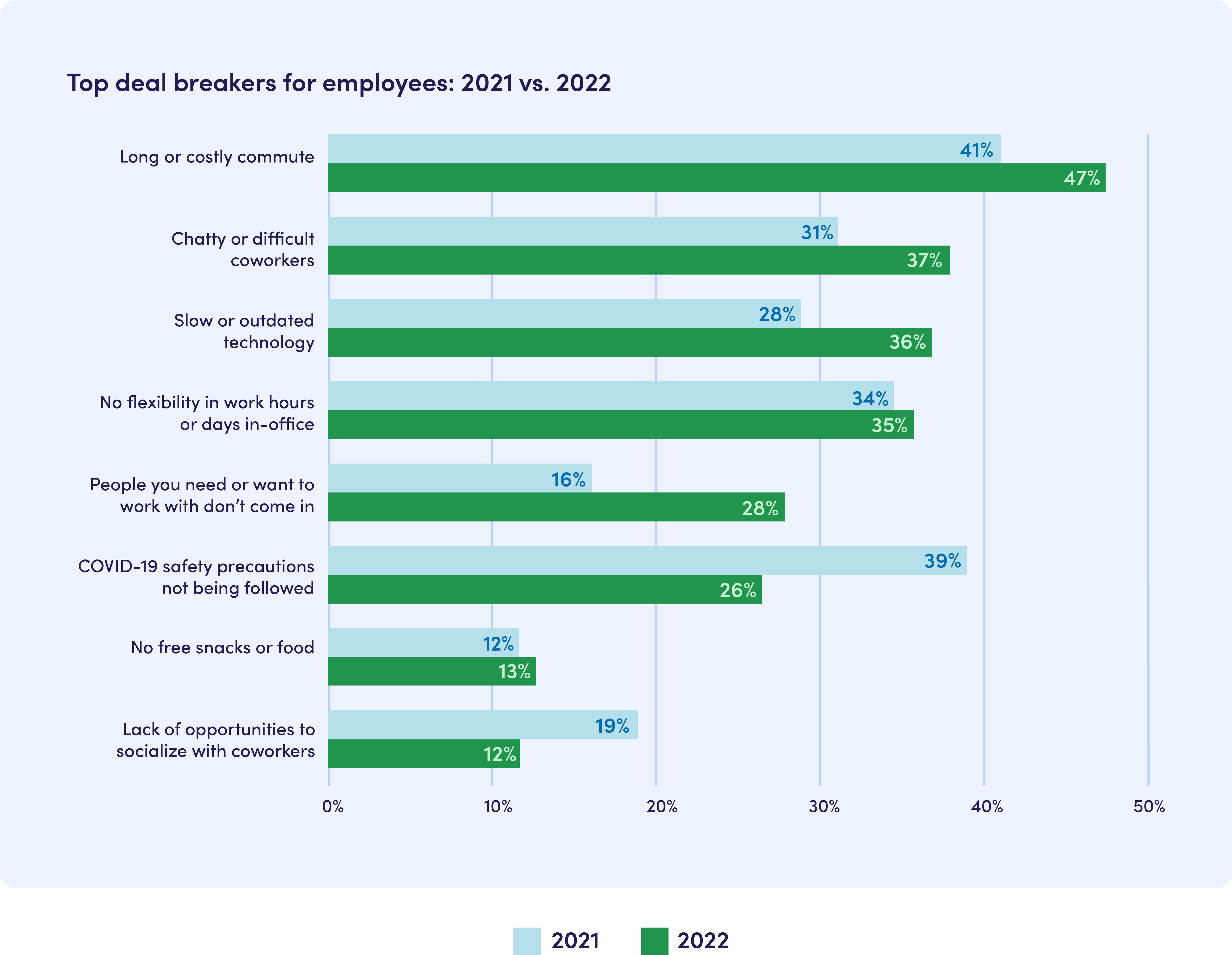The workplace offers an opportunity for people to come together and build community. But the workplace can look different to different people. Employees and executives have differing viewpoints when it comes to returning to the office. And while executives are aware of their employees’ new needs, they might not be moving very fast to address them. The first step in creating a workplace that works for everyone is to understand what employees’ major deal breakers are.So we surveyed 1,000 employees and 250 executives in the US to find out two things: what employees’ top deal breakers are and what executives think their employees’ top deal breakers are.
Executives are underestimating how employees feel about return-to-office deal breakers
Executives don’t always understand how employees feel about the workplace, especially when it comes to returning to the office. In our survey, we asked employees how they felt about nine big deal breakers. Their top deal breakers were long or costly commutes, chatty or difficult coworkers, and slow and outdated technology.On the flip side, we asked executives what they think are their employees’ biggest deal breakers for returning to work. Executives either overestimated or underestimated almost all the deal breakers. They were only right about one. This shows how big of a disconnect there is between what employees are feeling and what execs are thinking. Here are the biggest gaps between employees and executives:
- 47% of employees cite a long or costly commute as a deal breaker. Only 36% of executives think a costly commute is a deal breaker for employees.
- 12% of employees cite a lack of opportunities to socialize as a deal breaker. Executives overestimate this. 24% of executives think lack of socialization is a deal breaker for employees.
- 37% of employees cite chatty coworkers as a deal breaker. Only 28% of executives think chatty coworkers are a deal breaker for employees.

Slow and outdated technology has become a big return-to-office deal breaker
In our report, we found that 36% of employees said slow or outdated technology was a deal breaker for returning to the office. This number is up 8 percentage points since our last survey in 2021. Technology in the workplace is important to employees. It allows them to seamlessly enter the building, book a desk, communicate with their teammates, join virtual calls, and more. Without high-quality tech solutions in place, employees can get frustrated with their workplace. And are executives hearing this call for better technology? There’s a big gap between what executives think the big deal breakers are and what they actually are. When it comes to slow technology, executives are underestimating how big of a deal this is. 30% of executives cite slow tech as a deal breaker for employees, which is 6 percentage points lower than the employee response.Also, we found that Gen Z employees were the most frustrated with slow technology. 57% of Gen Z employees reported slow tech as a deal breaker while the rest of the generations averaged around 33%.

Younger employees want more opportunities to socialize in the office
Unsurprisingly, younger employees are more interested in socializing and making friends at work. We found that 22% of Gen Z employees said lack of opportunities to socialize with coworkers was a deal breaker. The rest of the generations averaged around 11%. Plus, employees over the age of 40 were more likely to cite chatty coworkers as a return-to-office deal breaker (39%) compared to those under 40 (34%). Those earlier in their careers are likely more invested in networking and making connections via the workplace that can help them grow their careers. Plus, Gen Z employees have had to grow their careers out of the pandemic. So they want the opportunity to share their contributions in an office setting or work closely with their managers.
To find out if there was any truth to this, we asked all generations how they felt about people they need to work with not coming in. 35% of Gen Z employees said this was a deal breaker while the rest of the generations averaged around 27%.

The takeaway
There are still hesitations and deal breakers employees face around coming into the office. However, executives aren’t putting time, money, and strategy towards solving those deal breakers. Instead, they are overestimating how concerned employees are about Covid-19 safety precautions and socialization opportunities while underestimating how important technology and quiet spaces in the office are. These gaps between employees and executives can make or break employee retention and their workplace experience.
The first step in closing this gap is to better understand what those deal breakers are and align together on a solution. Send out quarterly or monthly surveys and collect data from your employees on how they feel. This will inform your workplace leadership and exec team on how to be strategic with any new policy changes or new technology you introduce into the workplace.
It will take time to address every deal breaker. But by making an effort to close the gap, you can help create a more cohesive work environment for everyone. If you’re interested in learning more about Envoy’s workplace tech solutions, check out our workplace platform.
Read more
Searching for a visitor management solution? Learn what to look out for and how to choose the best tech for your team.
Managing your space well doesn’t have to be difficult. But if you want to be successful, you need the right approach.
A well-run workplace can set your team up for success. Learn why workplace management matters and how to do it right.
Workplace security is critical to the future of your business. Learn why it matters, what threats to watch for, and how to strengthen your workplace security plan.
In this post, we’ll explore what workplace compliance is and how to build a compliance culture for your organization.
With more folks sending personal packages to the workplace, having a sound mailroom management system in place is key.









